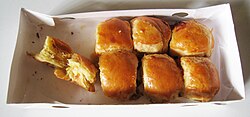
Puff pastry, also known as pâte feuilletée, is a flaky light pastry made from a laminated dough composed of dough and butter or other solid fat. The butter is put inside the dough, making a paton that is repeatedly folded and rolled out before baking.

Pastry is baked food made with a dough of flour, water, and shortening that may be savoury or sweetened. Sweetened pastries are often described as bakers' confectionery. The word "pastries" suggests many kinds of baked products made from ingredients such as flour, sugar, milk, butter, shortening, baking powder, and eggs. Small tarts and other sweet baked products are called pastries as a synecdoche. Common pastry dishes include pies, tarts, quiches, croissants, and pasties.

A Danish pastry is a multilayered, laminated sweet pastry in the viennoiserie tradition. It is thought that some bakery techniques were brought to Denmark by Austrian bakers, and originated the name of this pastry. The danish recipe is however different from the Viennese one and has since developed into a Danish specialty.

A mille-feuille, also known by the names Napoleon in North America, vanilla slice in the United Kingdom, and custard slice, is a French dessert made of puff pastry layered with pastry cream. Its modern form was influenced by improvements made by Marie-Antoine Carême.
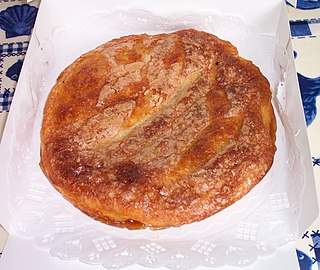
Kouign-amann is a sweet Breton cake made with laminated dough. It is a round multi-layered cake, originally made with bread dough, containing layers of butter and incorporated sugar, similar in fashion to puff pastry albeit with fewer layers. The cake is slowly baked until the sugar caramelizes and the butter expands the dough, resulting in its layered structure. A smaller version, kouignette, is similar to a muffin-shaped, caramelized croissant.

Kuih are bite-sized snack or dessert foods commonly found in Southeast Asia and China. It is a fairly broad term which may include items that would be called cakes, cookies, dumplings, pudding, biscuits, or pastries in English and are usually made from rice or glutinous rice. In China, where the term originates from, kueh or koé (粿) in the Min Nan languages refers to snacks which are typically made from rice but can occasionally be made from other grains such as wheat. The term kuih is widely used in Malaysia, Brunei, and Singapore, kueh is used in Singapore and Indonesia, kue is used in Indonesia only, all three refer to sweet or savoury desserts.
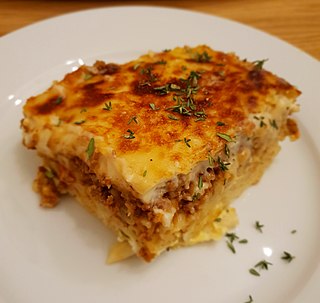
Pastitsio is a Greek baked pasta dish with ground meat and béchamel sauce, with variations of the dish found in other countries of the Mediterranean Sea.
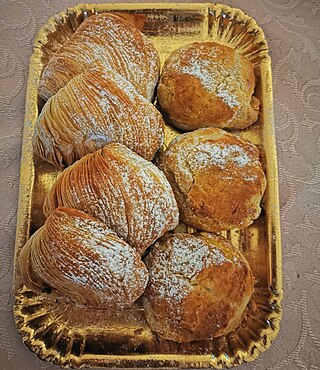
Sfogliatella, sometimes also known as a lobster tail, is a shell-shaped Italian pastry with a sweet or creamy filling, originating in the Campania region. Sfogliatella means 'small, thin leaf/layer', as the pastry's texture resembles stacked leaves.

A curry puff is a snack of Southeast Asian origin. It is a small pie consisting of curry with chicken and potatoes in a deep-fried or baked pastry shell. The consistency of the curry is quite thick to prevent it from oozing out of the snack. Pap or puff reflects the Fujian Chinese dialect 泡 ('pop'), which means 'bubble, blister, puffed'. It is a truly Southeast Asian snack as it has Indian, Chinese or Malay elements.
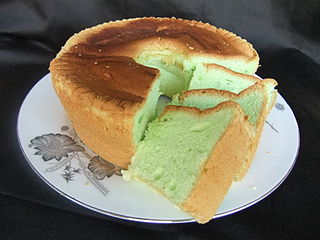
Pandan cake is a light, fluffy, green-coloured sponge cake flavoured with the juices of Pandanus amaryllifolius leaves. It is also known as pandan chiffon. The cake is popular in Malaysia, Indonesia, Singapore, Vietnam, Cambodia, Laos, Thailand, Sri Lanka, Hong Kong, China, and also the Netherlands. It is similar to the buko pandan cake of the Philippines, but differs in that it does not use coconut.

Kue is an Indonesian bite-sized snack or dessert food. Kue is a fairly broad term in Indonesian to describe a wide variety of snacks including cakes, cookies, fritters, pies, scones, and patisserie. Kue are made from a variety of ingredients in various forms; some are steamed, fried or baked. They are popular snacks in Indonesia, which has the largest variety of kue. Because of the countries' historical colonial ties, Koeé (kue) is also popular in the Netherlands.

Spekkoek is a type of Indonesian layer cake. It was developed during colonial times in the Dutch East Indies. The firm-textured cake is an Indo (Dutch-Indonesian) version of the European multi-layered spit cake. However it is not baked on a rotating spit, and contains a mix of Indonesian spices, such as cardamom, cinnamon, clove, mace and anise. The cake is made of flour and yolk and is rich in butter or margarine.

Custard tarts or flan pâtissier/parisien are a baked pastry consisting of an outer pastry crust filled with egg custard.

Dobos torte, also known as Dobosh, is a Hungarian sponge cake layered with chocolate buttercream and topped with caramel. The layered pastry is named after its inventor, Hungarian chef József C. Dobos, a delicatessen owner in Budapest. In the late 1800s, he decided to create a cake that would last longer than other pastries in an age when cooling techniques were limited. The round sides of the cake are coated with ground hazelnuts, chestnuts, walnuts, or almonds, and the hardened caramel top helps to prevent drying out, for a longer shelf life.

A torpedo dessert is a buttery, flaky viennoiserie bread roll, filled with pastry cream, named for its well-known torpedo shape. Croissants and other viennoiserie are made of a layered yeast-leavened dough. The dough is layered with butter, rolled and folded several times in succession, then rolled into a sheet, in a technique called laminating. The process results in a layered, flaky texture, similar to a puff pastry.

Bahulu or baulu is a traditional Malay pastry (kue/kuih). It is similar in concept to the madeleine cake, but round in shape and composed of different ingredients. There are three versions available, the most common being bahulu cermai (star-shaped) and the more elusive bahulu gulung and bahulu lapis (layered). Bahulu is believed to be originated in Malay Peninsula during the colonization era and is the corruption of the Malaccan Kristang word, bolu which means cake. It is usually served during Eid al-Fitr as well as during the Lunar New Year.

Paratha is a flatbread native to the Indian subcontinent, with earliest reference mentioned in early medieval Sanskrit, India; prevalent throughout the modern-day nations of India, Pakistan, Nepal, Bangladesh, Maldives, Afghanistan, Myanmar, Malaysia, Singapore, Thailand, Mauritius, Fiji, Guyana, Suriname, and Trinidad and Tobago where wheat is the traditional staple. It is one of the most popular flatbreads in the Indian subcontinent and the Middle East. Paratha is an amalgamation of the words parat and atta, which literally means layers of cooked dough. Alternative spellings and names include parantha, parauntha, prontha, parontay, paronthi (Punjabi), porota, paratha, palata, porotha, forota, farata, prata, paratha, buss-up shut, oil roti and roti canai in Malaysia and Indonesia.

Pie susu is an Indonesian custard tart pastry consisting of a shortcrust pastry filled with egg custard and condensed milk. This traditional Indonesian dessert pastry is very flat with only one very thin layer of custard. The origin of this pastry is from Bali.
